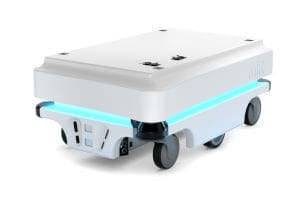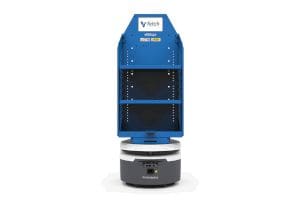Accelerating Picking With Warehouse Robots
Autonomous Mobile Robots (AMRs) have been gaining popularity in the warehousing industry, especially for order picking. Picking is the process of selecting items from a warehouse inventory to fulfill customer orders. It is traditionally a crucial and labor-intensive supply chain task that can determine the overall warehouse efficiency and success of a warehouse operation.
But now with advances in technology, there are clear competitive advantages to be gained by using AMRs in order picking. CSSI can assist companies in more rapidly attaining these benefits. A knowledgeable consultant such as CSSI is a significant asset when implementing these warehouse robots.
In the Warehouse Operation, What is Order Picking?
Warehouse picking is the process of selecting products for one or multiple orders from warehouse inventory for customer order fulfillment. This can involve selecting products from shelves, pallets, or bins, and preparing them for shipping. Picking is a critical operation for any warehouse, as it directly impacts customer satisfaction and overall fulfillment efficiency. Accurate and timely picking can lead to faster delivery times and increased customer loyalty, while inaccurate or delayed picking can lead to customer complaints and lost sales.
Challenges Companies Face Running an Efficient Warehouse Picking Process?
Running an efficient warehouse picking process is not without its challenges. Traditionally, the picking process involves printing out the day’s orders and assigning picks to warehouse operators. Facilities which utilize mobile technology, may utilize mobile computers running a warehouse management system in lieu of paper. Each order picker then fans out across the warehouse to locate items, and transports his or her picks to a packing or shipping area where orders will be boxed and shipped.
Some of the most common picking challenges faced by companies include:
- Labor shortages : In the tight labor market, many companies are struggling to find and retain skilled laborers for their picking operations. This has led to increased labor costs, slower picking times, and higher error rates. In worst-case scenarios, warehouses may simply not have adequate staff to meet daily demand.
- Increasing customer demands : In spite of warehouse labor challenges, customers are expecting ever faster delivery times and more accurate orders than ever before. This puts pressure on warehouses to improve their picking processes to meet these demands.
- Inventory management : Maintaining accurate inventory levels is critical to efficient picking. If inventory levels are inaccurate, it can lead to delays in picking times or incorrect orders. Thus, the correct item must be picked, and warehouse inventory systems must be correctly adjusted to provide management with sufficient inventory visibility to avoid stockouts or order shipping delays.
- Safety concerns : Picking is often a physically demanding task for the warehouse worker, and accidents can occur if safety protocols are not followed. This can lead to injuries and increased liability for the warehouse manager.
Picking Contributes Significantly to Order Fulfillment Costs
Industry data clearly shows the cost of picking operations and the potential benefits of streamlining this process. According to a study by the Material Handling Industry (MHI), order picking represents 55% of the total cost of warehouse operations. This means that any improvements made to the picking process can have a significant impact on the overall cost of running a warehouse.
What is the difference between ‘case picking’ and ‘each picking’?
- Case picking involves selecting full cases of products to fulfill customer orders. This is a common method for fulfilling orders of large quantities of the same product.
- Each picking involves selecting individual items to fulfill customer orders. This is a more challenging process, as it requires warehouse operators to locate and select individual items from inventory. Each picking is often required for orders that contain a variety of products, such as e-commerce orders.
One of the biggest challenges of Each picking is the time it takes to locate and select individual items. This can lead to longer picking times and lower order accuracy. Additionally, each picking can be physically demanding and may increase the risk of worker injuries.
Autonomous Mobile Robots Support a More Efficient Picking Process
AMRs are a powerful tool to create a more efficient picking process through warehouse automation. While autonomous robots are not currently able to perform the actual picking operation in most warehouses, they can eliminate the travel waste of the warehouse pickers. Instead of forcing employees to walk the warehouse and repeatedly return to the pack-out of shipping area (which can involve substantial travel distance in many modern facilities), the employee can pick the items associated with an order or group of orders, place these on the autonomous mobile robot, and let the AMR transport the items to pack-out.
This elimination of travel is not only less physically taxing for employees… it also creates significantly more time for the employee to stay on task picking the next group of orders! Companies can take this a step further by assigning employees to individual aisles or sections, with the AMRs regularly arriving to pick up assigned items. This type of operation can reduce travel time and waste even further.
Overall, using AMRs for order picking can lead to faster picking times, higher order accuracy, and reduced labor costs. This can help warehouses to meet increasing customer demands and improve their overall efficiency.
CSSI carries solutions from two leading manufacturers of autonomous robots: Mobile Industrial Robots (MiR) and Fetch Robotics . After reviewing your workflow requirements, CSSI can make a recommendation on a quality warehouse robotics solution.
Choosing a Knowledgeable Consultant When Implementing Warehouse AMRs
Implementing AMRs for warehouse automation is a complex process that requires careful planning and execution. Choosing a knowledgeable consultant can help companies to navigate this process and ensure that they get the most out of their investment. A knowledgeable consultant like CSSI can help companies to:
- Assess their warehouse operations and identify areas where AMRs can provide the most value.
- Develop a customized solution that meets their specific needs and requirements.
- Ensure that the AMRs are integrated seamlessly with existing warehouse management systems.
- Train employees on how to use and maintain the AMRs.
- Monitor performance and make adjustments as needed to optimize the overall picking process.
In addition to these benefits, working with a knowledgeable consultant like CSSI can help companies to avoid costly mistakes and ensure a smooth and successful implementation of AMRs in their warehouse.
In conclusion, autonomous mobile robots are an ideal solution for warehouses looking to improve their order picking process. By using advanced sensors and navigation systems, AMRs can navigate the warehouse, locate products, and fulfill orders with increased accuracy and efficiency. However, to maximize the benefits of using AMRs, companies should work with a knowledgeable consultant who can help them to identify the best solutions and ensure a successful implementation. By doing so, they can improve their overall efficiency, meet increasing customer demands, and stay competitive in the ever-evolving warehousing industry.
Contact CSSI for Picking with Autonomous Mobile Robots
To discuss implementing AMRs for order picking in your warehouse, contact CSSI . We’d be glad to speak about your project and advise you on a solution.





